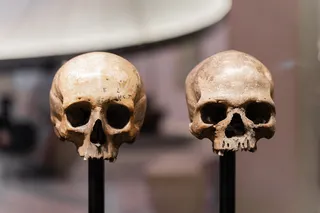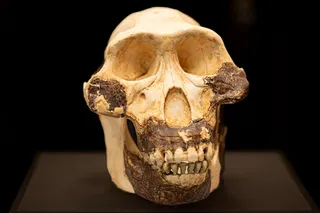Neanderthals stopped roaming Earth around 40,000 years ago. Yet as time passes, new technologies are helping scientists learn more about Homo neanderthalensis, how they might have lived, and what similarities they may have shared with Homo sapiens. There’s even a debate about what Neanderthals sounded like.
Scientists have long debated whether Neanderthals were capable of speech. Some argue that Neanderthals lacked the anatomical ability to even produce sounds.
In the 1980s, scientists discovered the skeleton of a Neanderthal male in Kebara Cave, Israel. Known as Kebara 2, the skeleton was well intact and allowed scientists to examine the neck bones. In particular, they found that the hyoid bone was similar to humans, which prompted researchers to think that Neanderthals were capable of speech.
But what did the Neanderthal sound like? And what did language mean to them?
Read More: Did Neanderthals Speak? Breakthrough Study Suggests Our Ancient Cousins Could Talk
High-Pitched Voice Theory
The high-pitched voice theory was introduced in a 2010 BBC documentary, Neanderthal: The Rebirth, in which producers worked with a famed vocal coach, Patsy Rodenburg. Producers gave Rodenburg a model of a Neanderthal vocal tract and provided details on the Neanderthals’ anatomy.
Rodenburg was told that Neanderthals had wide noses with large nasal cavities, broad rib cages, and a short voice box. Rodenburg then coached an actor, Elliot, into changing his voice to accommodate these traits.
An impressively straight-faced Elliot said “one, two, three” in his normal speaking voice before advancing into the Neanderthal traits. He pitched his voice higher on command and then gave it a more nasal quality to reflect the Neanderthals’ wide nasal cavities.
Rodenburg suggested that the Neanderthals’ heavy skulls would have pulled down on their throats while their large rib cages would have allowed for chest resonance. Thus, she provided a grip for Elliot to push down and out while he repeated the exercise.
The result? A high-pitched voice that one might not associate with a heavy-browed, barrel-chested Neanderthal.
Read More: 20 Things You Didn't Know About ... Neanderthals
Did Neanderthals Have a Language?
The high-pitched voice theory is controversial, and some scientists argue the Neanderthals likely sounded more like Homo sapiens.
“The vocal tract reconstructions have been highly criticized as not necessarily accurate. I really don’t buy the high-pitch voice theory,” says Rolf M. Quam, a paleoanthropologist, professor, and chair of the anthropology department at Binghamton University in New York.
Quam says high-pitched voice theory is too focused on bones and discounts how soft tissues would have shaped the sounds Neanderthals made. Without these tissues to determine the length and structure of the vocal tract, Quam says scientists can’t be fully sure what Neanderthals sounded like.
But Quam says there is increasing evidence that Neanderthals were capable of hearing and producing language. Although scientists don’t know the extent of the sophistication of the language, he thinks they were capable of producing a range of sounds.
“It wouldn’t be grunting and shrieking like chimpanzees,” Quam says.
Human vs. Neanderthal Speech
Humans have different hearing patterns than other primates and Quam says this enables us to hear in the frequencies in which speech is produced.
In a 2021 study in Nature Ecology & Evolution, Quam was part of a research team that used computerized tomography scans to examine sound transmission in Neanderthals’ outer and middle ear.
The study found “that the auditory capacities in Neanderthals do not differ from those in modern humans.” Most notably, they found that Neanderthals would have been capable of hearing and understanding consonant sounds, which means they could have been capable of more sophisticated vocal communication.
Read More: The Fascinating World of Neanderthal Diet, Language and Other Behaviors
The Meaning of Language
Most scientists agree that Neanderthals likely had language. But what did that language mean to them? Without evidence of symbolic language in cave drawings or sculptures, it’s difficult for scholars to know how Neanderthals communicated.
Human language is symbolic, Quam says. We use words to symbolize objects (like trees or cars), and we speak of objects that aren’t present, meaning they aren’t situation-specific.
One scholar gives the example of how a baby repeats the word “kitty.” The baby might point to a kitty in the room that is present or an object that resembles a kitty. The baby might be using the word as a question to inquire about a family cat, not in the room. Or the baby could be using the word as a command to summon the cat from another room, a demand the cat will smugly ignore.
Could Neanderthals communicate similarly with symbolic language? Scientists aren’t sure. Quam says they need to see evidence of Neanderthals using symbolic language. Cave art, for example, would demonstrate an ability to create representative symbols. Currently, they don’t have the evidence they need to make such a determination.
However, in recent years, scientists have determined that Neanderthals had the hearing capacity to decipher language.
Read More: Neanderthals and Homo Sapiens Shared This Cave 50,000 Years Ago
Foreign Tongues
Without evidence of symbolic language in the archeological record, many scholars hesitate to say whether Neanderthals were capable of sophisticated speech. And there are other complicating factors that make it difficult for scholars to surmise how Neanderthals spoke.
One complication is how Neanderthals lived in small groups. The world population was small, and these groups didn’t often encounter each other. When they did, it’s possible they had different dialects and languages.
What did these groups sound like? Quam doesn’t think they had high-pitched voices. Rather, he thinks that if a group of modern humans walked up to a group of Neanderthals, we could likely just think of them as speaking a foreign language.
“You wouldn’t know what they were saying, but you would know what they were communicating with one another,” Quam says.
Read More: What Exactly Happened to The Neanderthals and Why Did They Go Extinct?
Article Sources
Our writers at Discovermagazine.com use peer-reviewed studies and high-quality sources for our articles, and our editors review for scientific accuracy and editorial standards. Review the sources used below for this article:
Antiquity. New Neanderthal remains associated with the ‘flower burial’ at Shanidar Cave
Journal of Human Evolution. Neandertal vocal tract reconstructions: A critical appraisal
PLOS One. Micro-Biomechanics of the Kebara 2 Hyoid and Its Implications for Speech in Neanderthals
Trends in Cognitive Science. Possible stages in the evolution of the language capacity
Nature Ecology and Evolution. Possible stages in the evolution of the language capacity















